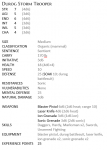LucasC
First Post
We completed our first full-night session of N.E.W. on Tuesday. If your interested, I provide some background on the session itself on my blog.
Here's the results of the playtest.
We played 3 battles. Most of this feedback comes from the latter two which involved the actual PCs.
Questions & General Feedback
Combat General
Here are some conclusions I come to after running the three battles (and why):
Pin Down
Everyone likes the concept of this tactic and, sometimes, they like the way it plays out in game. In other instances they find it to be unfair.
What they dislike about it, is that it feels unfair when a combatant engages a new target that has been immobile and (in many cases) not engaged at all previously.
Here’s an example.

In rounds 1, 2 and 3 everything works exactly as you think it should. It all ‘feels’ right. Then in round 4 the blue guy starts shooting at the second orange person. He gains a +3d6 on his attack even though this person has not been attacked yet. It feels unfair.
Couple of questions about Pin-Down
Another question that came up, that isn’t unclear in the rules but is a question of the ‘spirit’ of the pin-down mechanic.
Also, in times when the terrain they were using to hide behind would be unaffected by attacks, should the bonuses grow more slowly?
Lastly, tracking this mechanic for each participant adds a considerable amount of complexity to the game.
Crossfire
This mechanic had an awesome impact on combat. My players were jockeying to get into position to gain the crossfire bonuses every fight. As monsters moved, the PCs readjusted. Everything was in flux round-to-round. That was great.
Having said that, maybe I’m a dullard, maybe I’m not trying, maybe it’s the beer but… the 90 degree angle thing makes me not want to use this mechanic. It probably should be simple but my brain hurts trying to figure out where I need my creatures standing or when a PC is at a 90 degree angle. Something simpler would go a long ways towards improving this.
Grenades
So we tossed around a lot of grenades. Actually, I had to stop throwing grenades because I would have wiped out the PCs entirely.
Here’s why…
There’s really almost no reason not to just load down w/grenades and blow everyone up all the time. You’ll hit every time, you’ll hit a group and damage is comparable. It is expensive, that's the only downside.
The PCs hated the grenades, even though they had their own.
Dying
In the last combat (6 PCs v 3 aliens) the PCs won but not before 3 of them were knocked unconscious. They all were stabilized, but only because we read the rules wrong. On a later reading I picked up the following:
(emphasis mine)
Here are the difficulties we used:
The actual difficulties should have been doubled. The weapons dealing damage were 3d6 rifles. In all three cases at least one, and in some cases more than one, exploding d6 resulted in high damage.
If the targets had been correct, as shown below, the latter two would certainly have died, while the first one probably would have.
Is that intentional? I have to assume these results, and the difficulties noted above, are not going to be highly unusual since they are the results of the only 3 attacks that dropped PCs for the night.
Here's the results of the playtest.
We played 3 battles. Most of this feedback comes from the latter two which involved the actual PCs.
- PC Setup: each armed with a laser pistol (2d6), 3 armed with a laser rifle (3d6) and one armed with a heavy polaron gun (5d6); each PC has armor totaling 5 SOAK
- Alien Setup: each alien has a laser pistol (2d6) and 2 (of 4) had a laser rifle (3d6). Each alien has armor totaling SOAK 10.
Questions & General Feedback
- When two or participants tie initiative who goes first?
- How should moving diagonally be counted? 1, 1.5, 1-2, etc.
- Too many weapons do 2d6 damage, everyone would like to see some variety here where possible
- It felt odd that armor absorbed sonic damage
- Is there meant to be a limit on Emergency First Aid or can a person with, say 15 damage, get Emergency First Aid repeated 15 times w/routine checks and get back to full hit points
- Are there any penalties for shooting into a crowd? Is there a chance to hit bystanders when/if you miss your target?
- Is there a way to add the covering fire to a group? In our situation a small group of civilians (4 total) were running away from the gunfight and one of the PCs wanted to cover them. As it turns out, he could only give one of them cover.
- When a character is dying, is the countdown pool equal to their END score (as explicitly stated) or the associated dice pool? Meaning, if my END is 4, is my countdown 4 dice or 3 dice?
- Two of my players have statistics that run towards brains and not brawn. They felt like the game didn’t give them an equal footing w/those that have high physical attributes.
- What is the range increment for grenades?
- What happens if I miss with my grenade?
Combat General
Here are some conclusions I come to after running the three battles (and why):
- It is difficult to connect with attacks
- In most instances the defense numbers we are shooting at right now, be they my monsters or the PCs, are on the high end of the scale or even out of reach without modifiers -
- Successful attacks are deadly
- It wasn’t unusual for a single attack to disable the target – and that was even with armor ranging from SOAK 5 to SOAK 10. Exploding dice played a key part in this.
- Tactics play an important role in successful combat
- This is the way you overcome #1 above. Using tactics such as pin down and crossfire the PCs were able to reliably connect w/their targets.
- Mobility is important
- Both to position yourself to gain tactical bonuses and to avoid the penalties associated with not moving.
- Exploding dice significantly impact encounters
- Ignoring the free-for-all brawl where everyone died, we had 3 PCs and 4 aliens fall unconscious. At least 4 of those were put down due to exploding dice. And that only accounts for the damage element, the to-hit exploders also resulted in many attacks succeeding that would have failed.
Pin Down
Everyone likes the concept of this tactic and, sometimes, they like the way it plays out in game. In other instances they find it to be unfair.
What they dislike about it, is that it feels unfair when a combatant engages a new target that has been immobile and (in many cases) not engaged at all previously.
Here’s an example.

In rounds 1, 2 and 3 everything works exactly as you think it should. It all ‘feels’ right. Then in round 4 the blue guy starts shooting at the second orange person. He gains a +3d6 on his attack even though this person has not been attacked yet. It feels unfair.
Couple of questions about Pin-Down
- Does the ambush turn count when calculating pin-down penalties?
- Do pin-down penalties accumulate at the end of you turn, or the end of all participants turn and the beginning of the next round of play
Another question that came up, that isn’t unclear in the rules but is a question of the ‘spirit’ of the pin-down mechanic.
- If I’m hiding behind a pile of crates and get killed and my buddy runs up behind that same pile of crates that has been getting ‘chipped away little by little’ does he get any of my pin-down penalties?
Also, in times when the terrain they were using to hide behind would be unaffected by attacks, should the bonuses grow more slowly?
Lastly, tracking this mechanic for each participant adds a considerable amount of complexity to the game.
Crossfire
This mechanic had an awesome impact on combat. My players were jockeying to get into position to gain the crossfire bonuses every fight. As monsters moved, the PCs readjusted. Everything was in flux round-to-round. That was great.
Having said that, maybe I’m a dullard, maybe I’m not trying, maybe it’s the beer but… the 90 degree angle thing makes me not want to use this mechanic. It probably should be simple but my brain hurts trying to figure out where I need my creatures standing or when a PC is at a 90 degree angle. Something simpler would go a long ways towards improving this.
Grenades
So we tossed around a lot of grenades. Actually, I had to stop throwing grenades because I would have wiped out the PCs entirely.
Here’s why…
- In gunfights, an alien shoots at a PC w/his gun. More often than not, the attacks will miss.
- Same alien tosses a grenade. Now he’s targeting a defense of 5 – trivially easy to hit – and does automatic damage to anyone within 1 square.
There’s really almost no reason not to just load down w/grenades and blow everyone up all the time. You’ll hit every time, you’ll hit a group and damage is comparable. It is expensive, that's the only downside.
The PCs hated the grenades, even though they had their own.
Dying
In the last combat (6 PCs v 3 aliens) the PCs won but not before 3 of them were knocked unconscious. They all were stabilized, but only because we read the rules wrong. On a later reading I picked up the following:
The character providing the medical attention rolls an INT check as normal (with appropriate bonus die). This takes two actions (a full combat turn). The difficulty value of the check is equal to twice the damage of the final attack which dropped the patient (twice the number recorded above).
(emphasis mine)
Here are the difficulties we used:
- 14
- 20
- 21
The actual difficulties should have been doubled. The weapons dealing damage were 3d6 rifles. In all three cases at least one, and in some cases more than one, exploding d6 resulted in high damage.
If the targets had been correct, as shown below, the latter two would certainly have died, while the first one probably would have.
- 28
- 40
- 42
Is that intentional? I have to assume these results, and the difficulties noted above, are not going to be highly unusual since they are the results of the only 3 attacks that dropped PCs for the night.


